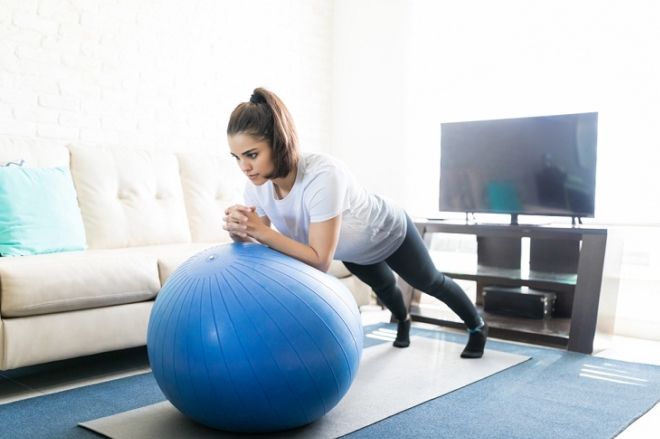It’s known by many names – exercise ball, stability ball, gym ball, balance ball, and even Swiss ball – and has several wonderful benefits. These big bouncy balls are found in every gym these days but can also be used at home to include in your exercise regimen. In fact, these balls are a great way to improve strength, cardio endurance, and balance.
Leading fitness experts say that stability balls can help train your abs, improve your posture and balance, and can strengthen your back and core. The best part about this ball is that you don’t need to be a gym expert to use it and can easily incorporate it into your workout routine at home by learning how to use it effectively. Moreover, it won’t even take much space, is cheap and lightweight, and can be quickly inflated and deflated.

Before you decide on getting one of these balls, however, you must know which is the right size for you. For example, people between 5 feet and 5.5 feet should choose a 55-centimeter ball. Those who are between 5’6 and 5’11 should opt for a 65-centimeter ball. Lastly, a 75-centimeter ball would be ideal for people between 6 feet and 6’3 in height.
Now, let’s take a look at some common and easy stability ball workouts that will be beneficial for your whole body.
1. Single-Leg Bridge
Benefits: Increased posterior chain strength, improved proximal hip and core stability, and better hip dissociation.
Step 1: Lie faceup on the floor behind the ball with your knees bent. Place your feet on the ball and your arms on the floor by your sides. Now slowly raise your hips off the floor until your upper back is stabilized.
Step 2: Pause and then slowly raise one leg straight up. Lower the leg and then return to start. Repeat after 30 seconds and keep alternating the legs. Perform 2-3 sets on each side.
2. Incline plank

Benefits: Works on the abdominal muscles as well as the other ab muscles and the core muscles that run from the pelvis along the spine and up to the shoulder girdle.
Step 1: Place the stability ball on the floor and get into a pushup position with your hands on it. Rest your weight on your elbows on it.
Step 2: Hold your body in a straight line from head to heels. Make sure that your hips don’t sag. Maintain this position for at least 20-30 seconds. Do 3-5 sets and rest for 30 seconds after each set.
3. Wall Squats
Benefits: Works your quadriceps, gluteal muscles (a set of smaller muscles located in the buttocks), hamstrings, hip flexors, and core.
Step 1: Place the stability ball up against a wall and make sure it braces against your back. Now, lower down into a squat position until your legs form 90-degree angles at the knees.
Step 2: Use the ball to support your back and roll it from your lower back to your shoulder blades. Squat down low to deepen the move and provide more stability. Complete 10 to 15 reps (repetitions).
Note: Make sure that your knees don’t roll out to the sides during the exercise. They should be in line with the rest of your body.
4. Hamstring curl
Benefits: Works your gluteal muscles, hamstrings, and core.
Step 1: Lie on your back and put your calves and heels on the stability ball. Your arms should be on your sides and your palms should be facing down.
Step 2: Move your hips upward by squeezing your gluteal muscles and hamstrings until your body is straight. Engage your core and extend your legs straight out, moving the ball away from you. Slowly lift your hips and bend your knees.
Step 3: Roll the ball back in by pulling your heels towards your buttocks until the soles of your feet touch the ball. Now, stretch your knees and lower your hips and back to the floor. Repeat. Complete 12 to 15 reps.


